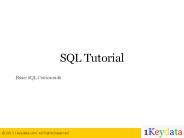SQL - PowerPoint PPT Presentation
1 / 18
Title:
SQL
Description:
Grouping. Sometimes we want to apply aggregate functions to subgroups of tuples ... has a GROUP BY clause that allows for specific grouping of attributes ... GROUP BY Dno; ... – PowerPoint PPT presentation
Number of Views:17
Avg rating:3.0/5.0
Title: SQL
1
SQL
- SQL stands for Structured Query Language
- SQL allows you to access a database
- SQL is an ANSI standard computer language
- SQL can execute queries against a database
- SQL can retrieve data from a database
- SQL can insert new records in a database
- SQL can delete records from a database
- SQL can update records in a database
2
History
- Was designed and implemented by IBM Research
(1986) - A joint with American National standards
Institute (ANSI) and International Standards
Organization (ISO) led to the standard version of
SQL-86 - A revised and expanded in 1992 called SQL-92.
- Most recent is now SQL-99
3
Definitions and Data Types
- Uses terms table, rows, columns for the formal
relational model terms relations, tuple, and
attribute. - An SQL schema is identified by a schema name,
including authorization identifier to indicate
user who owns it and descriptions for each
element. - Schema elements include tables, constraints,
views, domains, and other constructs - Catalog a named collection of schemas in an SQL
environment
4
Common Data Types
- char (size) Fixed length character string. Size
is specified in parenthesis. Max 255 bytes. - varchar (size) Variable-length character
string. Max size is specified in parenthesis. - number (size) Number value with a max number of
column digits specified in parenthesis. - date Date value
- number (size, d) Number value with a max number
of digits of size total, with a max number of
d digits to the right of the decimal.
5
Creating Tables
- Create Table used to specify a new relation by
giving it a name, and attributes with initial
constraints. - Example CREATE TABLE company.employee
- Company is the schema name
- Employee is the relation name
6
Creating a Table
- Create table myemployees
- (firstname varchar(30),
- lastname varchar(30),
- title varchar (30),
- age number(2),
- salary number(8, 2))
- Creates a table called myemployees
- First name, last name, and title allows 30
characters each. - Age is allowed 2 digits
- Salary is allowed 8 digits with 2 decimals
7
Other Functions
- Select allows you to select a certain and
retrieve data specified. - Example Select column1
- From TableName
- Where condition
- Select column 1 from the TableName with the
following condition.
8
Insertion
- Insert into tablename
- (first_column, last_column)
- values (first_value,last_value)
- Insert into employee
- (first, last, age, address, city, state)
- values (James, Tran, 23, 1111 1st street,
San Jose, California)
- Inserts into specified table name
- Specify all columns inserting to separated by a
comma. - Values inserted are specified afterwards
- Strings enclosed in single quotes, numbers are
not.
9
Updating
- update tablename
- set columnname newvalue
- ,nextcolumn newvalue2
- where columnname
- OPERATOR value
- and or column
- OPERATOR value
- optional
- Update the specified table name
- Set the column specified with new value
- Add in conditionals if needed
- Optional values and input add
10
Deleting
- delete from tablename
- where columnname
- OPERATOR value
- and or column
- OPERATOR value
- optional
- Delete a certain table, column, row, etc.
- Operator meaning gt,lt,, etc
11
Drop
- Dropping a table removes all rows and
definitions. - Example Drop table TableName
12
Ordering
- SQL allows you to order elements in a table.
- Example orders by alphabetical
- select distinct customer-name
- from borrower, loan
- where borrower.loan-number loan.loan-number
and branch-name Perryridge - order by customer-name
13
Evaluation of GroupBy with Having
14
Aggregates
- More functions that allow you to operate on sets.
- COUNT, SUM, AVG, MAX, MIN
- Produces numbers, not tables.
- Not part of relational algebra
- Example Select MAX (Age)
- From Employee E
15
Grouping
- Sometimes we want to apply aggregate functions to
subgroups of tuples in a relation. - Such as finding the average salary of employees
in each department or the number of employees
that are working on each project. - SQL has a GROUP BY clause that allows for
specific grouping of attributes
16
Grouping Cont
- Example
- SELECT Dno, COUNT(), AVG (Salary)
- FROM EMPLOYEE
- GROUP BY Dno
- The EMPLOYEE tuples are partitioned into groups,
each group having the same value for the grouping
attribute Dno. - Then the COUNT and AVG functions are applied to
each group.
17
b)
T
T
a)
c)
S
R
A
A1
A1
A2
A2
A2
A3
A4
A5
A
A2
A3
A
A1
A2
A4
A5
A
A1
A2
A3
A4
R(A) EXCEPT ALL S(A)
d)
T
A
A2
A3
R(A) INTERSECT S(A)
Two tables
SQL Multiset Operations
R(A) UNION ALL S(A)
18
Nested Queries
- List all courses that were not taught in S2000
- SELECT C.CrsName
- FROM Course C
- WHERE C.CrsCode NOT IN
- (SELECT T.CrsCode --subquery
- FROM Teaching T
- WHERE T.Sem S2000)
- Evaluation strategy subquery evaluated once to
- produces set of courses taught in S2000. Each
row - (as C) tested against this set.































